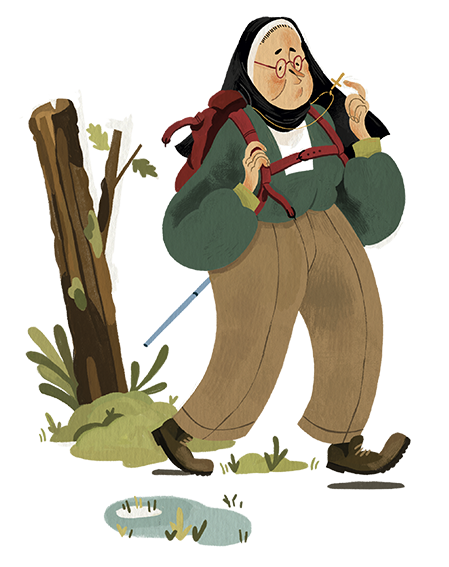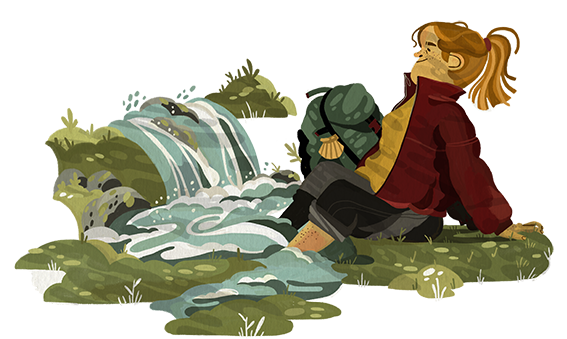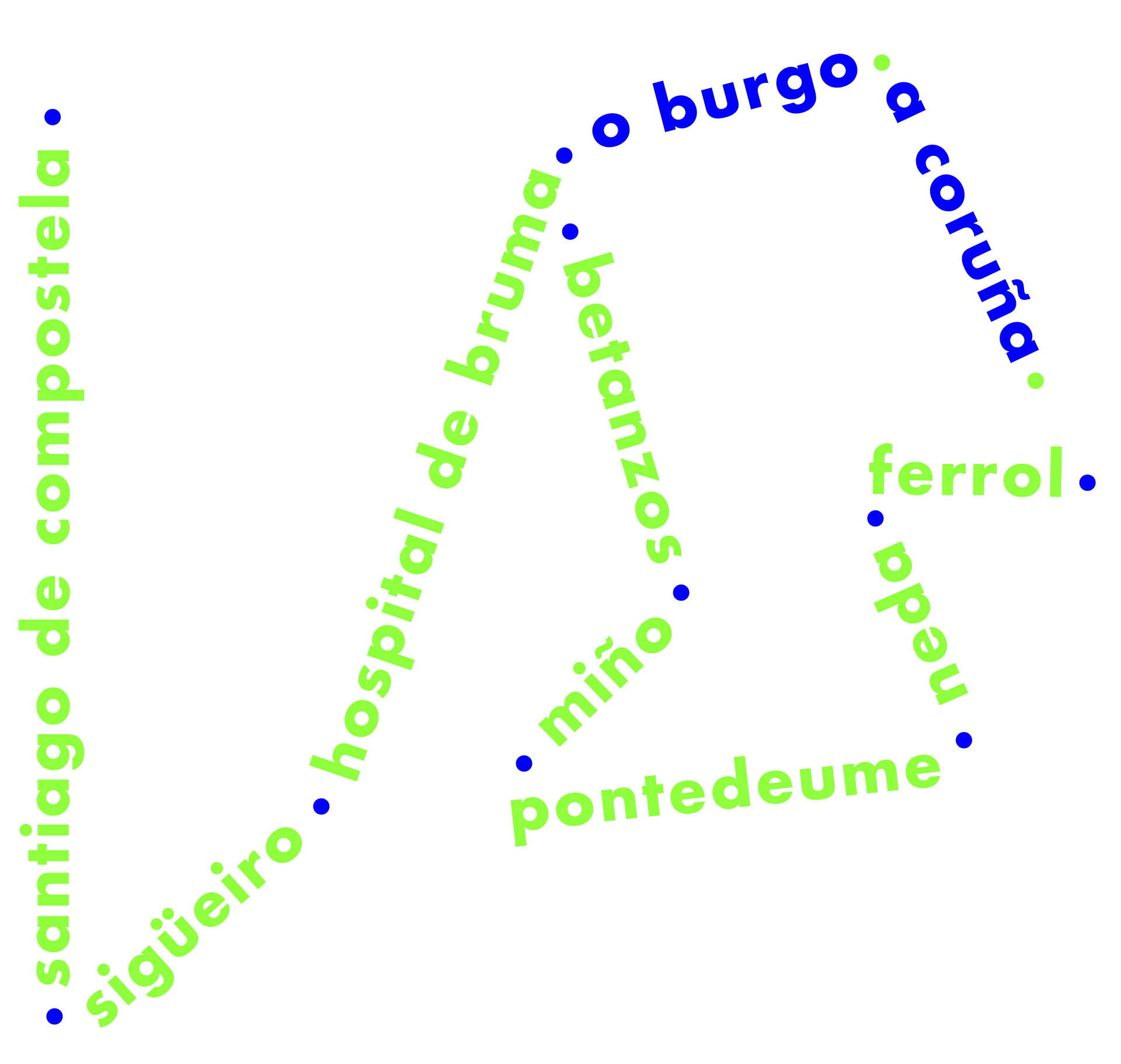the english way
The so-called ENGLISH WAY is the shortest of all the pilgrims’ routes to Santiago and is limited to Galicia, and more specifically, the province of A Coruña.
Historically, it was the route taken by pilgrims travelling by sea from northern Europe, particularly from England, from where waves of pilgrims sailed throughout the later Middle Ages.
A Coruña was the principal port for pilgrims, particularly in the 14th and 15th centuries, before the Anglican schism brought about by Henry VIII of England. However, given the proximity of this city to Santiago de Compostela (75 km), today Ferrol, the second largest port in the Ártabro Gulf, is the most popular starting point for this route (116 km to Santiago).
According to the data released by the Pilgrimage Office in Santiago, in 2019 almost 16,000 pilgrims completed this Way, accounting for 4.5% of the total, a figure that has experienced steady growth in recent years. Ferrol is now the fifth most popular city of departure for pilgrims.
 Along the Way you will find the legacy of the great and noble medieval knight Fernán Pérez de Andrade ‘the Good’, who constructed no fewer than seven bridges, seven hospitals, seven monasteries and seven churches especially for you…
Along the Way you will find the legacy of the great and noble medieval knight Fernán Pérez de Andrade ‘the Good’, who constructed no fewer than seven bridges, seven hospitals, seven monasteries and seven churches especially for you…
Even though we stick to the coastline, in Galicia it is impossible to avoid hills and slopes, although in this case it is a fairly easy route, free from major obstacles apart from the sharp elevation between the regions of As Mariñas and Terra de Ordes, which is even steeper on the section leading from A Coruña.
This Way is therefore suitable for walkers of all abilities, boasting numerous coastal attractions and idyllic inland landscapes comprising pastures and farmland, and above all, woods.
As for its built heritage, the city of A Coruña is home to a Roman lighthouse, listed as a UNESCO World Heritage site, whilst Ferrol, with its magnificent Age of the Enlightenment architecture, is a candidate for inclusion on the same list. The Way also takes us through another two historic towns: Pontedeume and Betanzos.
However, it must also be said, that it includes many built-up areas, taking pilgrims through a number of industrial estates. It also runs parallel to several stretches of motorway and along more tarmacked surfaces than we would wish for, although there are also a number of alternative routes.
 Yet my dear friend, do not forget to feast your eyes and stomach on the numerous culinary delights of this land: peppers from O Couto, bread from Neda, costrada pies in Pontedeume, the delicious Betanzos omelette, and turnip greens from Monfero and Ordes…
Yet my dear friend, do not forget to feast your eyes and stomach on the numerous culinary delights of this land: peppers from O Couto, bread from Neda, costrada pies in Pontedeume, the delicious Betanzos omelette, and turnip greens from Monfero and Ordes…
The number of hostels is limited, but alternative accommodation options normally offer special rates for pilgrims. Booking is advised in the summer months, especially in the coastal area of Pontedeume, which is a popular spot with tourist.
From Ferrol, the English Way can be completed comfortably in five days, and just three or four from A Coruña. Those unfamiliar with the terrain should spend at least one day exploring their starting point – namely Ferrol or A Coruña -, and of course, another visiting the historic city of Santiago de Compostela. All in all, the English Way will take up a mere week of your time.


HOW TO GET TO FERROL OR CORUÑA
-The quickest way is undoubtedly to fly into A Coruña’s Alvedro Airport (LCG), which has connections with Madrid, Barcelona, Valencia, Seville, Alicante-Elche, Bilbao, Palma de Mallorca, Gran Canaria, Tenerife and London. The city centre is 8 km away and there is a scheduled bus service that operates every 30 minutes between 7.15 a.m. and 9.45 p.m. that will take you as far as the Old Town (Abente y Lago Hospital) for just €1.55 . Alternatively, you can take a taxi, which will cost you between €20 and €25. You can start your route here, or travel to Ferrol by Arriva’s bus or take the much slower Renfe’s train.
-From Rosalía de Castro Airport (Santiago de Compostela) you will have to take the bus of Empresa Freire to the city centre that operates day and night for just €3. From the bus station, you can continue your journey to Ferrol, which will take 1 hour and 20 minutes and costs €8 (www.monbus.es/en/). There is also a direct bus service to A Coruña from the airport that departs at 10.30 a.m. and 10.15 p.m. from Mondays to Fridays, and at 10.15 p.m. at the weekends. Another option is to take the train to Coruña. There is a frequent, fast service that takes just 30 minutes and costs €7.60, but we strongly advise against travelling by train from Santiago de Compostela to Ferrol.
-A Coruña and Ferrol can also be reached by train or coach from a number of cities in Spain, Portugal and other European countries.
sections
all about ferrol
WHAT TO DO IN FERROL
description
Must-dos for pilgrims
– Vía Compostellam Pilgrimage Office. Paseo da Mariña, s/n. Tel: + 34 981 944 252. Located at the start of the English Way.
– San Xián Co-cathedral, where there is a pilgrims’ assistance service in the sacristy between 10.30 a.m. and 1 p.m. and 6 p.m. to 8 p.m. Mass is celebrated every day at 11 a.m. and 7.30 p.m., and also at 1 p.m. on Sundays.
– Plaza de España Tourist Information Office. Tel + 34 981 944 251.
-A final alternative is the Domus Ecclesiae (Rúa Miramar, s/n, Canido). Tel + 34 981 353 295. Open from 8.30 a.m. to 2.15 p.m. and 4 p.m. to 6.30 p.m. from Monday to Thursday. On Fridays it is open only in the morning.
![]()
![]()
![]()
![]()
![]()
![]()
![]()
![]()
Not to be missed
– The Age of the Enlightenment in Ferrol (A Madalena district) with its grid street plan, two large squares, buildings with the classic gallery windows and countless examples of Modernist architecture designed by Rodolfo Ucha.
– San Xián Co-cathedral, an understated Neo-classical building, the work of Sánchez Bort, in keeping with the style that predominates in this city, which has no time for elaborate Gothic edifications.
The two Navy museums, the only ones of their kind in Spain: the Naval, history museum and Exponav, which is dedicated to the shipbuilding industry.
Our suggestions
-Stock up on food supplies at A Madalena market, which overlooks the main façade of the Co-cathedral. It is open from 7 a.m. to 4 p.m. from Monday to Thursday, until 9 p.m. on Fridays and 3 p.m. on Saturdays. It also opens on the third Sunday of the month, coinciding with the city’s fair.
Take a stroll around the Canido district, filled with murals inspired by Velazquez’s Las Meninas, and home to an intriguing Natural History Museum, located in the square, which is lined with street cafés.
-Discover one (or more) of the delightful cafés before indulging in a route around the tapas bars in the city centre streets (see lists). Alternatively, take a boat trip across the ria to Mugardos (from July to September, with departures on the hour and returning on the half hour between 11 a.m. and 2 p.m. and 4 p.m. to 8 p.m.) in order to sample the famous stewed octopus, the only place in Galicia where it is prepared this way.
ferrol – betanzos




THE FERROL-BETANZOS STRETCH (48.8 km)
description
We will be making our way along the Ártabro Gulf, along the shores of three of the tidal estuaries that comprise the Rías Altas and crossing a number of bridges, including some of those that were built on the orders of Fernán Pérez de Andrade in the 14th century.
Don’t criticise the bridge until you have reached the other side of the river. (Proverb)
[let us not have prejudices about something without having all the information or experience, and let us not say bad words about someone who can help us]
After leaving Ferrol, the Caranza district and A Gándara industrial estate, heading in the direction of the end of the tidal estuary, a pleasant walk will bring us to Neda, although the hand of man is clearly in evidence due to the succession of sea promenades. Instead of crossing the Xubia stone bridge, take the dual arch cable-stayed pedestrian bridge for a shortcut of some 500 metres.
![]()
![]()
![]()
![]()
![]()
![]()
![]()
![]()
Neda, which in the Middle Ages was far more prosperous than Ferrol, is a popular option for spending the night.
Neda and Pontedeume are separated by a succession of uphill and downhill climbs. After the Vilar do Colo Business Park, which has eliminated the historic path along the Way, there are two crossroads on the N 651 road where walkers must take extra care due to the heavy traffic.


![]()
![]()
![]()
![]()
![]()
![]()
![]()
![]()
Pontedeume, which is accessed via a long medieval bridge, is one of the most picturesque and liveliest towns on the English Way, and is therefore chosen by many as the end of this stage.
We will work up a sweat on leaving Pontedeume as we make our way up a hill that even the sense of achievement on reaching Santiago will not allow us to forget. Fortunately, the first shady copses and the medieval bridge of Baxoi make their appearance before we come to Miño and its spectacular beach.
The stretch between Miño and Betanzos is quieter and more bucolic; in parts a kind of a balcony overlooking the tidal estuary of the same name and its wetlands.
Betanzos is undoubtedly the historic site that best reflects the spirit and essence of the medieval pilgrimage, as it conserves the urban layout dating back to this period and three Gothic churches.
Our suggestions
-Take a break on the tree-lined promenade that backs Caranza Beach and watch the shellfish gatherers at work in the tidal estuary.
-Admire the Romanesque architecture of the Monastery of San Martiño de Xubia do Couto, and if you are fortunate to be spending the weekend there, you can explore the church, which opens in the morning.
-Admire the 16th century Christ in Chains (in the Church of Santa María de Neda), which was rescued from the destruction wrought by the Church of England and sold by Captain John Dutton.
-Also worth exploring in Neda is the charming porticoed street known as Rúa Real, admire the Gothic stone cross in front of the Church of San Nicolás, and don’t forget to try the deliciously crafted artisanal bread, amongst the finest in Galicia.
-In Fene, the locals seem to take everything in good humour. In addition to their Museum of Humour (admission is free), Castelao Park, located next to the Way and the ideal spot for taking a well-earned rest, has a monument to clowns.
-If you have time to spare, turn off the Way and walk for 400 metres to A Madalena Beach in Cabanas, backed by a delightful pine grove (the only thing that Pontedeume is missing is a beach!).
–Pontedeume will have leave you with lasting memories if you take a stroll around the harbour, visit the medieval tower built by the powerful Andrade family or wander around the cobbled streets of the historic quarter up to the Church of Santiago, which houses a beautiful 14th century seated figure of the Apostle.


-This is your last chance to take a dip in the sea or bask in the sun on a first class beach: Miño’s Playa Grande.
-Before making your way down to Betanzos, linger for a while in the Old Town and discover the Romanesque Church of San Martiño de Tiobre. Also worth visiting at the entrance to the town is the 16th century Shrine of Our Lady of the Way, who after all, is our protectress.
–There’s nowhere quite like Betanzos: 1. A medieval historic quarter filled with small squares, steep streets and city wall gates; 2. Three Gothic churches: Santa María, Santiago and San Francisco, each more interesting than the last; 3. The tomb of Fernán Pérez de Andrade ‘the Good’, supported by a bear and a wild boar, in the Church of San Francisco; 4. An encyclopaedia park built by returnee indiano emigrants overflowing with curiosities; 5. Los Hermanos Naveira square, lined with arches and street cafés, which on Sundays is the site of a bustling fair; 6. The increasingly popular Betanzos wine, made from the Branco lexítimo grape variety; 7. The famous runny omelette made with locally-grown potatoes; 8. And As Calexas and the surrounding area, full of bars serving a wide range of delicious tapas.
betanzos – santiago




BETANZOS-SANTIAGO DE COMPOSTELA STRETCH (66.7 km)
description
From As Mariñas, included on UNSESCO’s list of Biosphere Reserves, we must make our way up the steep slope that separates it from Terra de Ordes, a plateau dedicated to agriculture and livestock farming that will speed us on our way to Santiago de Compostela. From Hospital de Bruma, site from the 12th century onwards of a pilgrims’ hostel, the rest of the Way should be ‘as easy as pie’, although you can never be completely sure…
He who considers everything to be easy shall encounter difficulties in life. (Lao Tsé)
Indeed, we may be lulled into a false sense of security that from Betanzos it is all downhill; but in fact we will be crossing a series of valleys, the most important of which is the River Mero valley, nestling just outside Cos.
![]()
![]()
![]()
![]()
![]()
![]()
![]()
![]()
At this point the terrain becomes more densely wooded, and the Beche reservoir is followed by a steep climb up to As Travesas, situated just a short distance from Hospital de Bruma, an emblematic site on the English Way.
![]()
![]()
![]()
![]()
![]()
![]()
![]()
![]()
Farming villages, named after roads and streets (A Rúa, A Calle), are dotted along the route leading from Bruma and A Baxoia. The open meadows and fields planted with crops give way to wooded areas from Casanova onwards, home to an excellent public hostel.
![]()
![]()
![]()
![]()
![]()
![]()
![]()
![]()
Tall eucalyptus trees and a business park indicate that we are coming to Sigüeiro, the modern capital of the borough of Oroso that sprang up around the medieval bridge built on the orders of Fernán Pérez de Andrade ‘the Good’. Access to the town is via a delightful park with monuments that pay tribute to a number of illustrious pilgrims.


![]()
![]()
![]()
![]()
![]()
![]()
![]()
![]()
As we approach the end of the Way and the city of Santiago de Compostela, the scenery gradually changes, acquiring a more urban air. After walking through a magical oak grove, we come to the Tambre industrial estate. After passing Boisaca cemetery and the district of Meixonfrío, we enter the historic quarter via San Caetano, walking down Basquiños and Santa Clara streets and making our way to the Cathedral along the emblematic Troia and Acibechería streets. We have reached, without too much difficulty, Santiago de Compostela.
Our suggestions
-The Xente no Camiño Tavern-Museum in Presedo, an essential meeting point decorated with medieval-themed paintings by Alfredo Erias.
-Few places have greater symbolic meaning than Bruma Hospital. Standing at the bottom of the hill, it dates back to 1140, and its legacy remains today in the form of a pilgrims’ hostel.
-Even though you choose not to spend the night here, stop for a moment to admire the hostel in Casanova (Poulo), a former rectory that has been magnificently restored.
-Despite its image as a mere suburb, Sigüeiro offers locals and visitors alike the charming O Carboeiro Park, which includes a monument in honour of illustrious pilgrims of yesteryear. And next to the River Tambre, crossed by the medieval bridge that is still in use, there is a delightful path that extends upriver as far as the Island of O Refuxio.
– The final wood close to the River Sionlla before reaching Santiago is an unexpected treat, which can be reached either by the new layout through O Barral or along the original Formarís route, which boasts a delightful oak grove just after the Hotel Castro.
all about a coruña
WHAT TO DO IN A CORUÑA
description
Must-dos for pilgrims
-The pilgrim’s passport or credentials are issued in the Church of Santiago, the official starting point of the English Way. The parish office is open from Monday to Friday from 11.30 a.m. to 1.30 p.m., and from 6.30 p.m. to 7.30 p.m. Mass is celebrated daily at 8 p.m. and also at 12.30 p.m. on Sundays and public holidays.
-For information about the city, visit the Municipal Tourist Information Office. Plaza de María Pita, 6. Tel: + 34 981 923 093.
Not to be missed
–A Mariña, with its white gallery windows, overlooks the port where the ships carrying pilgrims once moored. Just behind it is the charming Plaza de María Pita, a square with a monument to the heroine that fought the children and grandchildren of those same pilgrims, who laid siege to the city under the orders of Drake, thirsty to seek revenge for the Spanish Armada. The Old Town is just a few steps away, the medieval town that boasts numerous attractions, including the Church of Santiago, the Collegiate Church of Santa María or San Carlos Gardens, the final resting place of another Briton, General Sir John Moore, who was mortally wounded in the battle fought against the French just outside the city. British friends, British enemies, in short, the British…
May we learn to navigate between false friends and true enemies. (Paulo Coelho)
-The Tower of Hercules, the only working Roman lighthouse, reclad in the 18th century and declared a UNESCO World Heritage Site in 2009.
-The sea promenade, particularly the stretch that backs Orzán Bay (and its city beaches), which fills with visitors and locals as soon as the sun peeks out from the behind the clouds.
Our suggestions
-A tour of San Antón Castle, which today houses a History and Archaeology Museum, standing on a former island that is now connected to the mainland, and boasts a collection of treasures dating back to the Bronze and Iron ages.
-If you like fish, but not only with chips, then you should head for the Finisterrae Aquarium, where you will find a replica of Captain Nemo’s submarine, surrounded by Atlantic species and sharks.
-To lose yourself – albeit only for a while – along the seemingly endless and always lively calles de los vinos, streets lined with tapas bars, including Estrella, Troncoso, Olmos, Galera, Barrera and La Franja.
a coruña – hospital de bruma




A CORUÑA-HOSPITAL DE BRUMA DETOUR (33.5 km)
description
The lighthouse that guided the ships carrying the seafaring pilgrims has its own particular Way of Saint James, although the route that leads from is very different from the ancient path. Each way has its own particular demons, and in this case, they are difficult road leading out of city of A Coruña, and the fact that it is a relatively short journey.
…The lighthouse that lights up the world lights up my life. (Revolver).



The route leading out of A Coruña would try the patience of a saint, with the exception of the sea promenade in O Burgo.
The second endurance trial comes as we make our way around Alvedro Airport and the nearby business park, although our patience will be amply rewarded on reaching the Church of Santiago de Sigrás, a haven of peaceful tranquillity.
Two manor houses – Drozo and Ancéis – indicate that we are coming to Sergude and its immaculate shelter. A little further on, we cross the River Barcés in Sarandóns, which marks the start of a steep climb up to As Travesas, where we join up with the route from Ferrol, just a short distance outside Hospital de Bruma.
Our suggestions
–O Burgo, with its Romanesque Church of Santiago and medieval bridge (legend has it that this is one of the seven built on the orders of Fernán Pérez de Andrade), is well worth visiting, as it is the site of the first port that welcomed pilgrims.
-If the door is open, take a look inside the Church of Santiago de Sigrás, where you can admire a Baroque seated figure of the Apostle Saint James, carved in the traditional Galician style; understandably so, as this is his home. You can also sit for a while in the park situated next to the church and recharge your batteries.
-In Sarandóns you’ll feel like royalty as you pass by the house where Philip II spent the night when he followed the way in the reverse direction in 1554 before setting sail for England: we should feel privileged to be able to visit the site where the most powerful man of his day once slept.







